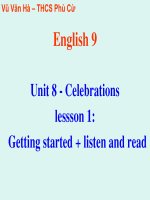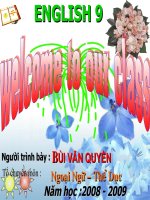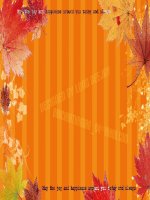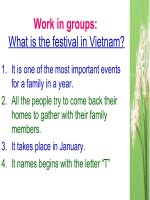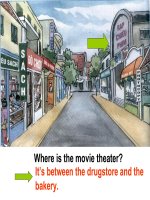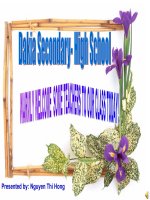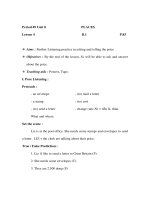period 50 unit 8 celebrations reading a objectives 1 educational aim students should know more about the celebration of tet and other festivals’ activities 2 knowledge general knowledge through this u
Bạn đang xem bản rút gọn của tài liệu. Xem và tải ngay bản đầy đủ của tài liệu tại đây (98.12 KB, 12 trang )
<span class='text_page_counter'>(1)</span><div class='page_container' data-page=1>
<b>Period 50</b>
<b> </b>
<b>Unit 8</b>
<b>: </b><b>Celebrations</b>
<b> </b>
Reading
<b>A. Objectives:</b>
<b>1. Educational aim: Students should know more about the celebration of Tet and</b>
other festivals’ activities
<b>2. Knowledge:</b>
- General knowledge: - Through this unit, students know the history of tet and some
kinds of celebration
- New words: Words related to celebration
<b>3. Skills: Reading for identifying the main idea and specific information </b>
<b>B. Teaching aids: Real objects, pictures, English textbook 11, hand-outs</b>
<b>C. Method: Integrated, mainly communicative</b>
<b>D: Contents:</b>
<b>I.Organization</b>
<b>Class Date of teaching</b> <b>Absent students</b>
Teacher’S activities Students’ activities
<b>II. Warm- up(6m)</b>
Brainstorm
- T shows some real objects and
pictures such as the pictures of
Banh Chung, peach blossom,
kumquat tree<b>…</b>., real objects as red
envelops, a box of candied fruits<b>…</b>.
- T points the pictures and real
objects and ask questions:
+ What do you think of when you
see this?
+ Why so?
+ What do you often do before Tet?
<b>III. New lesson</b>
<b>* Activitiey 1: Before you </b>
<b>read(10m)</b>
<b>Discussing Tet holiday</b>
-Ask Ss to look at the picture on
page 90 and discuss the 3
questions in pairs
- T goes around to offer help
- T calls on some Ss to present
their answer and elicits comments
from other Ss. T gives feedback if
necessary
1. What time of the year is it?
Pair work
I think of Tet holiday
Because they are the symblols
of Tet
Clean and decorate the house,
go shopping to buy new clothes,
candied fruits, make Banh
Chung<b>……</b>.
Pair work
It is Spring and it should be Tet
holiday because we can see
peach blossom and kumquat
tree full of ripe fruits
</div>
<span class='text_page_counter'>(2)</span><div class='page_container' data-page=2>
2. What are the people in the
picture doing?
3. What else do you see in the
picture?
Pre -teaching vocabulary
Lunar New Year
To fall between ..and<b>…</b> <b>………</b>
To spead:
To be full of
Candied fruit
Peach blossom /pi:t∫'blɔsəm/
Apricot blossom /'eiprikɔt
'blɔsəm/
Positive comments:
Ask Ss to make sentences with the
above words to check their
understanding
<b>* Activity 2: While you read</b>
<b>Setting the scene</b>
You are going to read a passage
about Tet holiday in Vietnam. While
you are reading, do the tasks in
textbook
<b>Task 1 (6m)</b>
Find the meanings of the words.
You can also use your dictionary
+ T writes these words on the
board
+ Ask Ss to read the passage
quickly and stop at the lines that
contain these words to guess their
meaning
1. grand: impressive and large
2. banner: along piece of cloth with
a message on it that is carried
between two poles or hung in a
public place to show support for st
3. sugared apples
4. agrarian: connected with farming
and the use of land for farming
5. pray: to speak to God especially
to give thanks or ask for help
6. excitement: the state of feeling
excited
<b>Task 2 (5m) </b>
happiness
In the picture we can see a
five-fruit tray on the ancestral altar
and a dish of fruits, a tray of
candied fruits and a banh chung
on the table.
Tết âm lịch
<b>Ri vo khong thi gian t</b>
n
kéo dài
đầy nhiều
Mứt
Hoa đào
Hoa mai
Những lời nói tốt đẹp
Whole class pay attention
Individual work
Trọng đại, hồnh tráng
Biểu ngữ, băng rơn
Táo tẩm đờng
Thc vỊ n«ng nghiƯp
CÇu ngun
</div>
<span class='text_page_counter'>(3)</span><div class='page_container' data-page=3>
Ask Ss to work individually to do
the task and discuss their answers
with their partners
Call on some Ss to give their
answers and ask them to explain
their choices
<b>Task 3(6m)</b>
- Ask Ss to work individually to do
the task, then discuss their
answer with their peers
- Call on some Ss to write their
answers on the board and ask
them to explain their choices
5. It is made from sticky rice, green
beans and fatty pork
6. Mut is candied fruit
7. Visiting friends and other family
members, exchanging wishes,
going to the pagoda, playing
games..
<b>* Activity 3: After you read(10m)</b>
- Ask Ss to work in groups to tell
eachother about their last Tet
holiday
- When all groups have finished, T
calls on some Ss to report their
ideas to the class
<b>Consolidation and</b>
<b>homework(2m)</b>
- T summarises the main points
- Ask Ss to learn by heart all of
the new words and give
examples
- Summarise the main ideas of
the passage
individual work and pair work
1, 2,4 – F
3, 5, 6 – T
Individual work and pair work
1. It falls sometime between
19th<sub> January and 20</sub>th<sub> February</sub>
2. Tet s preparations and <b>’</b>
celebrations used to be pread
over months
3, They are decorated with
coloured lights and red banners
4. They buy gifts, clean and
decorate their houses and cook
traditional foods
Group work
Whole class
<b>E. Valuation</b>
Ss may not have enough vocabulary to talk about the topic, so T should be
ready to help them
</div>
<span class='text_page_counter'>(4)</span><div class='page_container' data-page=4>
<b>Period 51</b>
<b>Unit 8: Celebrations</b>
<b> SPEAKING</b>
<b>I. Objectives</b>
By the end of the lesson Ss will be able to:
Talk about the celebrations of Tet and other festivals activities<b>’</b>
<b>II. Teaching aids</b>
Textbook, handouts, <b>…………</b>.
<b>III. Anticipated problems</b>
Ss may have limited linguistic resources for discussion, so T should be ready
to assist them
<b>IV. Procedure</b>
I.Organization
<b>Class Date of teaching</b> <b>Absent students</b>
Teacher’S Students’
<b>Warm up(8m)</b>
<b>Noughts and crosses</b>
Ask Ss to make sentences from the
words in the table
Peach
blossom Kumquat tree Candied fruits
Lucky
money Exchangewishes Banh chung
Relatives
and friends Special Tet foods pray
<b>Task 1 (8m)</b>
Ask the whole class to read the dialogue
silently
And ask them what points are metioned
in the dialogue
Then ask Ss to practice the dialogue in
pairs
Call some pairs to act out the dialogue
Work in group of 4 students
</div>
<span class='text_page_counter'>(5)</span><div class='page_container' data-page=5>
and give comments
<b>Task 2(14m)</b>
Ask Ss to look at the 3 pictures on page
93 and work out the name of each
holiday.
T checks with whole class and gives out
the correct answer
Ask Ss to list the activities people
usually do in these holidays and write
them quickly on the board so that Ss
can compare these with the information
they will deal with
Call on some Ss to give the answer and
ask other Ss to feedback.
<b>Task 3(13m)</b>
Get Ss to work in pairs to ask and
answer about the holiday in task 2. T
asks Ss to add any information about
holiday they know to make the D more
interesting
<b>Consolidation and homework(2m)</b>
T summarises the main points of the
lesson
Ask Ss to do exercises in workbook
E: Valuation: Ss learnt well
Whole class
Pic1: Mid- Autumn festival
Pic 2: Thanksgiving
Pic 3: Valentine s Day<b>’</b>
1. c C
2. a A
3. b B
Pair work
Whole class
<b>Period 52</b>
<b> Unit 8: </b>
<b>Celebrations</b>
<b> LISTENING</b>
<b>A. Objectives:</b>
<b>1. Educational aim: Students should know more about the New Year celebration in</b>
Japan.
<b>2. Knowledge:</b>
- General knowledge: Students listen for the main idea and comprehension questions.
- Language:
- New words: Words related to new year.
<b>3. Skills: Listening for gist and for specific information.</b>
<b>C. Method: Integrated, mainly communicative.</b>
<b>B. Teaching aid: Pictures ,text book. </b>
<b>D. Contents: </b>
I.Organization
</div>
<span class='text_page_counter'>(6)</span><div class='page_container' data-page=6>
Teacher’S activities Students’ activities
<b>II. Warm up (7m)</b>
Competition game- Guessing game
- T divides Ss into 2 groups: A and B
- T tells Ss the rule of the game: One
member from each group will go and
stand in the front of the class with their
back facing the board. T will write the
word/phrase which was learnt from the
previous lesson on the board. Other
Ss from each group have to explain
the word without mentioning it or
translating it into Vietnamese so that
their representative can guess the
word. The student with the quickest
and correct answer will get 1 point for
their group. Ss take turn to be the
representative. After some turns, the
group with more points will be the
winner.
<b>III. New lesson</b>
<b>* Activity 1: Before you listen(10m)</b>
<b>1. Guessing</b>
- T introduces the listening passage
- T asks Ss to work in pairs to guess
which of the activities on page 94 the
Japanese often do on their New Year s<b>’</b>
Day
- T calls on some Ss to give their
answers and write them on the
boards. T also asks Ss to add any
other activities that they think the
Japanese do at the New Year
<b>2. Pre-teaching vocabulary</b>
Shrine(n) /∫rain/
Longevity(n) [lɔn'dʒeviti]
Pine trees
Constancy(n)
To represent: to be symbol of sth
T may get Ss to make sentences with the
words and gives corrective feedback
<b>* Activity 2: While you listen</b>
<b>1. Task 1 (10m)</b>
Ask Ss to read read through the
statements
T plays the tape once for Ss to do the
task
T asks for Ss answers and write them on <b>’</b>
Group work
The word/phrase T may write on
the board are:
Thanksgiving, Mid-Autumn
festival, grand, pray, agrarian,
lucky money, Peach blossom
Apricot blossom<b>…………</b>.
Whole class pay attention
Pair work
iờn th, miờu th
tuụi tho
cây thông
s bn lũng, khụng thay đổi, trờng
tồn)
</div>
<span class='text_page_counter'>(7)</span><div class='page_container' data-page=7>
the board
T plays the tapes the second time for Ss
to check their answers
T asks Ss to work in groups of 4 to
compare their answers
Call some Ss to stand up and answer
<b>2. Task 2(8m)</b>
T asks Ss to read and answer the
questions with the things they remember
from the previous time of listening
T plays the tape again for Ss to do the
task.
After playing the tape, T gets Ss to work
in pairs and check their answers
T calls on some Ss to give the answers
and elicits feedback from other Ss.
<b>* Activity 3: After you listen(8m)</b>
T gets Ss to work in pairs to compare the
aspects of the Vietnamese New Year with
those of the Japanese one
Before Ss take part in the activity, T
elicits of the transition signal/phrases to
talk about the similarities and differences
between two things.
<b>Go around to offer help and collect Ss ’</b>
mistakes
Call some pairs to present their answers
Elicit feedback from the class and give
final comments
<b>IV. Consolidation and homework(2m)</b>
T summarises the main points of the
lesson
Ask Ss to learn by heart all new words
and do the exercises in workbook as
home work
Correct answer
- They put on special clothes
- Housewives prepare special
foods
- They go to a shrine
- They drind rice wine
- They watch television
- They eat a special meal
Individual work and pair work
1. B they want to get rid of the dirt
of the old year and welcome the
new year
2. from the television and radio
3. Kimonos or special dress
4. No, New Year is mostly
celebrated among family only
Pair work
Whole class
E: Valuation: Ss may not have difficulty doing the first task, so T should be
ready to give them some strategies
<b>Period 53</b>
<b> Unit 8: Celebrations</b>
</div>
<span class='text_page_counter'>(8)</span><div class='page_container' data-page=8>
<b>1. Educational aim: Students know how to describing a celebration.</b>
<b>2. Knowledge:</b>
- General knowledge: Students can write a passage describing a celebration.
- Language:
-New words : Words related to celebration.
<b>3. Skills: Describing a celebration. </b>
<b>B. Teaching aids: Some models, hand outs ,pictures.</b>
<b>C . Method: Intergraded, mainly communicative.</b>
<b>D. Contents: </b>
I.Organization
<b>Class Date of teaching</b> <b>Absent students</b>
Teacher’S activities Students’ activities
<b>II. Warm up (7m)</b>
Competition game- Christmas Cloze
- T divides the class into small groups
of 3-4 students. Then give handout for
Ss to do in their own groups. Ss have
to fill each blank in the passage with
one suitable word from the box. Which
group finishes first and has all the
correct answers will be the winner.
Christmas is an annual holiday that(1)
.the birthday of Jesus of Nazareth.
<b>……</b>
Christmas Day
falls on December 25. It is preceded by
Christmas Eve on December 24, and
in some countries it is (2)<b>…</b>..by Boxing
Day on December 26, <sub>when many </sub>
people go shopping for sales. It is a
(3)<b>……</b>when people get together
with(4)<b>……</b>Peole give(5)<b>……</b> to each
other or send(6)<b>…</b>..wishing each other
a(7)<b>……</b>.Christmas
At Christas, people(8)<b>…</b>carols to get
into the Christmas(9)<b>…</b>.As well,
people(10)<b>…</b>.Christmas trees and put
up(11) around the house. A common <b>…</b>
Christmas dinner is (12)<b>…</b>.There are
also lots of(13)<b>…</b>..goodies for the kids.
Group work
Answers:
1. marks 6. cards 11. lights
2. followed 7. merry 12.
turkey
3. holiday 8. sing 13.
baked
4. family 9. spirit 14.
peaceful
5. presents 10. decorate
</div>
<span class='text_page_counter'>(9)</span><div class='page_container' data-page=9>
People love Christmas because it is
the time when they can share(14)
.moments with their family.
<b>…</b>
III. New lesson:
<b>* Activity 1: Preparing Ss to </b>
<b>write(13m)</b>
- To prepare Ss for the writing task, T
uses the passage in the Warm-up
as a model
- T gets Ss to read the passage again
and discuss the main points
included in the passage in pair. At
the same time, Ss should write
down which sentences belong to
which main point
- Now get Ss to work individually to
writee an outline for their
description, using the main points
set in previous activities
<b>*. Activity 2: Writing(15m)</b>
- T gets Ss to describe the festival
they have chosen in 15 minutes
- T goes around to observe and offer
help with vocabulary or structures
<b>* Activity 3: Feedback on Ss’ </b>
<b>writings(8m)</b>
- T asks Ss to exchange their writing
with another student for peer
correction
- T goes around and collects
mistakes and errors
- Choose one or two descrition and
read it/them to the class
- Then T elicits corrective feedback
from the class and gives final
comments afterwards. T should
draw Ss attention to the <b>’</b>
organization of ideas and language
use
<b>IV. Consolidation and </b>
<b>homework(2m)</b>
- T summarises the main points of the
lesson
- For homework, T asks Ss to
improve their writing taking into
consideration their friends and T Ss<b>’</b> <b>’</b>
suggestions and correction
Suggested answers:
The description includes 6 main
points:
+ Name of the festival (sentence 1)
+ Purpose of the festival (sentence
1)
+ Time of the festival(sentence 2-3)
+Main activities of the festival/what
people do in the
festival(sentence4-7)
+Foods eaten(sentence8-9)
+ Peope s feeling about the <b>’</b>
festival(like/dislike? Reason(s)?)
(sentence 10)
Individual work
Mid-Autumn Festival is of my most
favourite festivals. It is held on the
15th<sub> day of the 8</sub>th<sub> lunar month every </sub>
year. It Ss the time when <b>’</b>
Vietnamese people celebrate the
largest full moon in the year. The
children have parties with special
cakes and grapefruits. They also
parade in the street with their
beautiful lantern, which come in all
shapes and sizes. Adults buy moon
cakes for their relatives and friends.
It is a great time for not only children
but also adults
</div>
<span class='text_page_counter'>(10)</span><div class='page_container' data-page=10>
E: Valuation: Ss may not have sufficient vocabulary to write about the topic,
so T should be ready to assist them
<b> </b>
<b>Period 54:</b>
<b> </b>
<b>Unit 8: Celebrations</b>
<b> LANGUAGE FOCUS</b>
<b>A. Objectives:</b>
<b>1. Educational aim: Students know how to distinguish the clusters /fl/ and /fr/ and/</b>
θr/ in a word or a sentences.
<b>2. Knowledge:</b>
- General knowledge: Students can Use pronouns :one(s), someone, no one ,anyone,
everyone appropriately.
- Language:
- New words: Words related to holiday and celebrations.
<b>3. Skills: </b>
- Pronunciation: fl/ - /fr/ and/ θr/
- Grammar: - pronouns :one(s), someone, no one ,anyone, everyone.
-Vocabulary about holidays and celebrations.
<b>C. Method: Integrated, mainly communicative.</b>
<b>B. Teaching aids: Textbook</b>
D. Contents:
I.Organization
<b>Class Date of teaching</b> <b>Absent students</b>
Teacher,S activities Students’ activities
<b>II. Pronunciation(12m)</b>
Distinguish sounds
- T models the clusters /fl/, /fr/,
and /θr/ for a few times
- T reads once for Ss to hear the
words containing these clusters. T
reads again and ask Ss to repeat
after
- Ask Ss to read the words in each
column out loud in chorus for a few
more times. Then T call on some Ss
to read the words out loud
Practicing the dialogue containing the
</div>
<span class='text_page_counter'>(11)</span><div class='page_container' data-page=11>
target sounds
- Ask Ss to work in pairs and take turn
to read aloud the given dialogue on
page 97
- Go around to listen and takes notes
of the typical errors
- Call on some Ss to read the D again
and provide corrective feedback
<b>III. Grammar</b>
<b>a. Presentation(6m)</b>
- T writes some sentences on the board
and asks Ss to comment on the of
one(s), someone, no one, anyone, and
everyone
-T asks Ss to give similar examples and
gives feedback
<b>b. Practice</b>
<b>III. Exercise:</b>
<b>1. Exercise 1(10m)</b>
Ask Ss to do exercise 1 individually and
then compare their answers with
another student. Then T calls on some
Ss to read out their answers
<b>2. Exercise 2(8m)</b>
T asks Ss to do exercise 2 in pairs. Ss
have to rewrite the sentences, using the
pronoun one/ones
Ask them to compare answer with
another pair
Call on some Ss to go to the board to
write their answers
Ask other Ss to feedback and gives
correct answers
<b>3. Exercise 3(7m)</b>
Use the words from the box to complete
Pay attention and give comments
on these examples
+ I don t like the red <b>’</b> <b>shirt, I prefer </b>
<b>the blue one</b>
+ Don t buy the sour <b>’</b> <b>oranges. Buy </b>
<b>the sweet ones</b>
+ There s <b>’ someone waiting for the </b>
director in the office
<b>+ Did someone call me last night?</b>
<b>+Have you met anyone like him?</b>
+ Don t tell <b>’</b> <b>anyone my secret</b>
<b>+ No one likes her story</b>
<b>+ Everyone laughs at him</b>
<b>+ Has everyone done your home </b>
work?
Individual work
1. anyone 2. someone 3. anyone
4. someone 5. no one
6. everyone 7. no one
1. Of the 3 bags, I like the blue one
2. Mai is making a fruit cake. Huong
is making one, too
3. I like reading books, especially
the ones about the natural world
4. I don t have a computer, and my <b>’</b>
father doesn t want me to have one<b>’</b>
5. They let me choose a pencil, and
I took the red one
6. There are several national
<b>One and one(s) are used to </b>
replace a previously mentioned
noun when we do not want to repeat
that noun. One replaces a singular
N and ones replaces a plural N
<b>Someone=somebody. It used with </b>
a singular verb in an affirmative
statement or a question when
speaker expects the yes answer<b>‘</b> <b>’</b>
<b>Anyone= anybody. It used with a </b>
singular verb in a negative
statement or a question
<b>No one usually takes a singular </b>
affirmative verb
<b> Everyone = everybody. It usually goes with </b>
</div>
<span class='text_page_counter'>(12)</span><div class='page_container' data-page=12>
the following sentences
Ask Ss to work individually to do
exercise
Then T calls on some Ss to speak out
loud
T listens and correct it if necessary
Suggested answers:
1. traditional 2. grand 3. gifts
4. celebrating 5. polite
6. good luck 7. excitement
<b>IV. Consolidation and homework(2m)</b>
T summarises the main point of the
lesson
Ask Ss to learn by heart grammar they
have learnt
celebrations in Vietnam but perhaps
the most meaningful one is Tet
holiday
7. We told each other both happy
stories and sad ones about our
lives
Whole class
<b>E Valuation: Ss may find it difficult to pronounce the three clusters, so T </b>
</div>
<!--links-->
